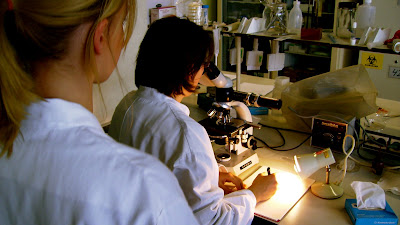 0
comments
12 December 2007
0
comments
12 December 2007
On 5 December 2007, the class of Science and the Public went to pay the Utrecht University Museum a visit. We entered the museum through a modern glass structure, which welcomed us in by its transparency and openness. The first room displays the collection of the Utrecht anatomist Jan Bleuland (1756-1838), which provides a comprehensive overview of anatomical practice in Utrecht at the time. We then entered the Knowledge Lab (KennisLab), which is an exhibition dedicated to scientific progress and the history of Utrecht University. After we enjoyed a tour by the curator, we were invited to manoeuvre through the room following a 5-step sequence. Going up the stairs led to the Youth Lab (JeugdLab) on the third floor, where children can explore science by means of doing fun and interactive experiments. A recreated, 18th century Natural History Cabinet (Rariteitenkabinet) and the Open Depot display specialised collections of animal specimens and physiological instruments.
In the early-19th century, a royal decree advised all universities of the Netherlands to acquire collections for teaching and study. Steven Shapin legitimised the idea that means should be introduced which show and explain the public how science progresses, because the support and credibility of scientists relies on public understanding. This, however, does not solve the problem how this is to be accomplished in a science museum. In this essay, I will attempt to give a critical analysis of the permanent exhibition of the Utrecht University Museum, which aims at communicating knowledge and progress in science to its visitors.
The Utrecht University Museum has a number of intentions and objectives it tries to adhere to. First, the museum wants to be a representative of Utrecht University itself: it serves as a symbol of the university by portraying its history, student life, and today’s science with temporary exhibitions. Second, the museum aims at fulfilling an educational role for schoolchildren and students alike. Especially for students of history of arts and sciences can the museum provide an informative and illuminating experience. Lastly, the museum’s objective towards the general public is to show the fascinating world of science. The general aim from these objectives can be summarised as offering its visitors with an understanding of science and the history of science at Utrecht University. By what means, then, does the University Museum try to accomplish this? And to what extent is it successful?
The museum experience at the Utrecht University Museum is an interesting one, because the museum seems to make use of two contrasting techniques in order accomplish its goals.7 On the one hand, the Bleuland Hall and the Natural History Cabinet stimulate a historical view on the way scientists saw their profession, but also show how late 19th century science museums looked like. Their technologies of enchantment are strong since the room is effective in creating this atmosphere. On the other hand, the Knowledge Lab and Youth Lab are two rooms in which an active role of the visitor is expected. Through interactivity and the availability of extensive information, the visitor can be educated in today’s science through an often entertaining manner. Semiophores not only display their place in history or to which discipline they refer to, but also function as a means to characterise a specific step in the process of science-making.
In the end, I argue that that the two techniques applied in the Utrecht University Museum can work to the advantage of the museum’s objectives as stated at the beginning of this essay. Although the visitor’s role in constructing meaning from displays is a necessity and that therefore much action of the visitor conditions the museum experience; nevertheless I argue that this is compensated by the fact that the museum offers a variety of a more traditional science exhibition and a modern type of conveying science-in-the-making, therefore shifting its emphasis from collections towards public.




